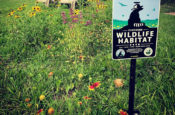Waldorf News
Homegrown for Good

By Jessics Snyder Sachs

On a recent morning in Cannon Falls, Minnesota, Karin Jokela and her daughter, two-year-old Ani, are exploring the wildlife flitting and buzzing about their backyard produce garden. Ani inspects a bumble bee on a coneflower, one of many native flowering plants growing among Jokela’s vegetables, herbs and berries.
“Is this the mama bee?” Ani asks, leaning closer—clearly intrigued by the busy visitor.
Jokela, a conservation biologist with the Xerces Society for Invertebrate Conservation, nurtures her daughter’s appreciation for the wildlife drawn to their food garden. Among the most exciting visitors have been the endangered rusty patched bumble bee. More-common native insects include pollinating sweat and squash bees, pest-eating wasps and ambush bugs and soil-building tiger and ground beetles.
This abundance of insects, in turn, draws swallows, bluebirds, chickadees and other songbirds as well as tree frogs and toads. The garden also is home to slug-eating garter and fox snakes and even the occasional salamander.
Like Jokela, more than 64 million Americans keep wildlife in mind when they garden, according to the National Wildlife Federation-sponsored 2020 National Gardening Survey. At the same time, around one in three households—more than 109 million people—grow at least some of their own food in home or community gardens. And that was before pandemic gardening spawned record-breaking sales for seed companies and plant nurseries. According to the chairman of the Burpee seed company, the firm sold more seeds during 2020 than any time in its 144-year history.
“These twin trends—mounting interest in growing your own food and cultivating wildlife-friendly native plants—spell good news for the environment, biodiversity and people,” says Mary Phillips, the Federation’s head of Garden for Wildlife™.
Tomatoes, lettuces, peaches and other fresh foods flourish in an organic garden (above) in Palo Alto, California. In Sebastopol, California, squash (below) supplies both vegetables and edible flowers.
Gardens to benefit biodiversity
“Home produce gardens are an excellent opportunity to increase biodiversity,” says conservation ecologist Henrik Smith of Sweden’s Lund University. “Their conservation value may be particularly important in cities where the surrounding landscapes have been intensely developed.”
He notes that the blossoms of many fruit and vegetable plants provide both nectar and pollen for native bees and flies. Squash bees, for example, feed almost exclusively on zucchini and other squashes. Tomatoes, peppers, blueberries, cranberries and fruit trees are favorites of native mason bees and bumble bees.
Fruit trees and berry bushes provide vital food for birds and omnivorous mammals such as raccoons and opossums. Peas, beans, herbs and leafy greens, meanwhile, offer egg-laying sites for many species of butterflies—from plain “cabbage whites” to dramatic long-tailed skippers and black swallowtails. These insects’ caterpillars nurture songbirds, especially nestlings, as well as predatory insects such as wasps, lacewings, ladybugs, fireflies and mantids.
To increase a home food garden’s wildlife benefits, “create a mosaic of habitats,” recommends Smith. “In general, the more untidy the gardens, the better they are for biodiversity.” Such “untidiness” includes tolerance for some wildlife-friendly weediness to provide shelter and additional food for insects, birds and other small animals. Interplanting or surrounding produce gardens with native flowers—a variety of species for continuous blooming—along with clump-forming grasses will also support more wildlife.
Several types of native-plant groupings are particularly beneficial to wildlife. “Insectaries,” for example, combine plant species that nurture predators—songbirds and predatory insects that also benefit gardeners by preying on pests such as aphids, scales, whiteflies, cutworms, stink bugs and slugs. Native asters, goldenrods, wild roses and blueberry bushes are ideal for such plant groupings.
from the National Wildlife Federation

 Apply Today: New Cohort Starts Nov. 2025
Apply Today: New Cohort Starts Nov. 2025 Transforming Voices Worldwide
Transforming Voices Worldwide Jamie York Books, Resources, Workshops
Jamie York Books, Resources, Workshops Resiliency and the Art of Education
Resiliency and the Art of Education Everything a Teacher Needs
Everything a Teacher Needs Caring for All Stages of Life
Caring for All Stages of Life ~ Ensoul Your World With Color ~
~ Ensoul Your World With Color ~ Middle School Science With Roberto Trostli
Middle School Science With Roberto Trostli Waldorf Training in Australia
Waldorf Training in Australia Full-Time Teacher Education
Full-Time Teacher Education Space speaks. Its language is movement.
Space speaks. Its language is movement. Bringing Love to Learning for a Lifetime
Bringing Love to Learning for a Lifetime Waldorf-inspired Homeschool Curriculum
Waldorf-inspired Homeschool Curriculum Summer Programs - Culminating Class Trips
Summer Programs - Culminating Class Trips Train to Teach in Seattle
Train to Teach in Seattle Bay Area Teacher Training
Bay Area Teacher Training Great books for Waldorf Teachers & Families
Great books for Waldorf Teachers & Families Immersive Academics and Arts
Immersive Academics and Arts Quality Education in the Heartland
Quality Education in the Heartland The Journey is Everything
The Journey is Everything Roadmap to Literacy Books & Courses
Roadmap to Literacy Books & Courses Flexible preparation for your new grade
Flexible preparation for your new grade Association for a Healing Education
Association for a Healing Education

 RSS Feeds
RSS Feeds